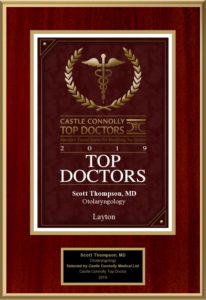Dr. Scott K. Thompson
Dr. Scott K. Thompson is a double board certified, facial plastic and reconstructive surgeon and in otolaryngology-head and neck surgery in Salt Lake City, UT. He completed a highly competitive fellowship in facial plastic surgery and has over 10 years of experience in this field. His education and training in the area of facial plastic surgery and hair restoration includes work at the University of Rochester with Dr. Timothy Doerr, a leader in facial reconstruction and trauma,
as well as a prestigious fellowship with world-renowned facial plastic surgeon and past president of the American Academy of Facial Plastic Surgery, Dr. Vito Quatela. As a Utah Plastic Surgeon, Dr. Thompson is devoted exclusively to the field of facial plastic surgery and is a skilled and respected facial plastic surgeon in this field. See Dr. Thompson on RealSelf.



Because Dr. Thompson’s practice focuses exclusively on conditions of the face, head, and neck, he is uniquely qualified in this area and is able to provide a comprehensive and holistic approach to the care of the face. Procedures include Facelift Surgery, Rhinoplasty (Nose Jobs), Otoplasty (Ear Surgery), Blepharoplasty (Eyelid Surgery), Hair Restoration and more. Additionally, his background in fine arts enhances his ability to balance the technical and creative aspects of his specialty and assists him in his goal of achieving natural surgical results that enhance each individual’s unique and attractive features. As a specialist of the face, Dr. Thompson also emphasizes a minimally invasive and preventive approach to facial and skin care that helps to maintain healthy, youthful features and overall health.
He is committed to the ethical, caring, and honest treatment of his patients and works very hard to earn and maintain their trust. Although patient care is his primary focus, Dr. Thompson’s academic, research, and teaching abilities have been recognized throughout his career with numerous awards as well as several scholarly publications. His love of teaching is evident as he educates his patients regarding their individual healthcare concerns and questions. One particular highlight for Dr. Thompson comes annually as he joins with several of his closest facial plastics colleagues from around the country in treating children with congenital deformities in Ecuador.
Dr. Thompson lives in Northern Utah with his wife and four children and enjoys playing the piano, backpacking, basketball, gardening, and most of all, spending time with his family. He also serves on the Davis County Medical Society medical board and recently served as President of the Davis County Medical Society. When considering a physician for your face, trust your face to a facial plastic surgeon. Trust your face to Dr. Thompson.
See What Our Patients Have To Say!
"Fantastic team & very knowledgeable. I would highly recommend UFP to anyone. Dr. Thompson is a highly skilled surgeon with an artistic eye and that’s incredibly hard to find."
To read more patient reviews, click here.
- Fellowship Facial Plastic and Reconstructive Surgery, Dr. Vito C. Quatela, University of Rochester School of Medicine
- Chief Resident Otolaryngology – Head and Neck Surgery, Strong Memorial Hospital and affiliated university hospitals, Rochester, New York
- Residency Otolaryngology – Head and Neck Surgery, Strong Memorial Hospital and affiliated university hospitals, Rochester, New York
- Internship General Surgery, Strong Memorial Hospital and affiliated university hospitals, Rochester, New York
- Medical School University of Rochester School of Medicine, Rochester, New York
- Undergraduate Premedical Education and Bachelor of Arts, Piano Performance, Utah State University, Logan, Utah
- International Society of Hair Restoration Surgery
- American Board of Otolaryngology – Head and Neck Surgery
- American Board of Facial Plastic and Reconstructive Surgery
- American Academy of Facial Plastic and Reconstructive Surgery
- American College of Surgeons
- 2013 Vitals “Most Compassionate Doctor”
- 2013 Vitals Patient Choice Award
- 2012 Vitals Patient Choice Award
- Alpha Omega Alpha, Medical Honor Society
- American Academy of Otolaryngology – Head and Neck Surgery Research Award, 1st Place
- Paul Harrington Outstanding Clinical Paper Award
- John D. Norante Outstanding Research Award
- Commendation for Outstanding Academic Performance, University of Rochester School of Medicine
- 2014 Frist Humanitarian Award from Lakeview Hospital
- RealSelf “Top Doctor”
- 2013 Best of Draper (in Surgeon & Physicians category)
- 2013 Best of Layton (in Surgeon & Physicians category)
- 2015 Best of Draper (in Surgeon & Physicians category)
- 2015 Best of Layton (in Surgeon & Physicians category)
- 2015 & 2016 “10 Best” Plastic Surgeons in Utah
- 2016 “Doctor’s Choice Award”
- 2016 Best of Layton (in Plastic & Reconstructive Surgeons category)
- 2018 Castle Connolly Top Doctor
- 2018 10 Best Plastic Surgeons in Utah
- 2019 Castle Connolly Top Doctor
Dr. Douglas Henstrom
Dr. Douglas Henstrom is an established facial plastic and reconstructive surgeon and head and neck surgeon (otolaryngology). Dr. Henstrom joined Utah Facial Plastics in early 2017 after careful selection by Dr. Thompson based on his impressive credentials, experience and surgical results. Dr. Thompson has also had the pleasure of working with him on a number of medical missions in previous years and has witnessed his work first-hand.
Dr. Henstrom believes “plastic surgery should not look or feel plastic,” and provides natural-looking results, which is what all providers at Utah Facial Plastics are known across the country for.


Prior to joining Utah Facial Plastics, Dr. Douglas Henstrom was considered one of Iowa’s best-trained Facial Plastic surgeons. He first developed a love and passion for plastic and reconstructive surgery while working with his father-in-law, the late Dr. Blayne Hirsche of Provo. After receiving his undergraduate degree from Brigham Young University in 1999, where he also earned academic all-conference awards as a member of the football team, he then completed medical school at the University of Iowa.
He continued his training by specializing in Head and Neck surgery at the Mayo Clinic and was subsequently selected for a highly competitive two-year fellowship in Facial Plastic and Reconstructive surgery at Harvard through the Massachusetts Eye and Ear Infirmary, where he refined the necessary skills to become a leader in his field. He continued his efforts in research and clinical teaching at the University of Iowa and has published multiple articles and textbook chapters in the field of plastic surgery.
For the last 5 1/2 years, he has been the director of Facial Plastic and Reconstructive surgery in the Otolaryngology department at the University of Iowa, perennially one of the top programs in the country. There he had the responsibilities of a busy clinical practice, as well as the education and training of the next generation of physicians. During this time he has taught and trained over 30 residents and fellows in the art and science of facial surgery. Dr. Henstrom excels at teaching and has even provided lectures to the BYU pre-med students about how to get into medical school.
With your face as your identity, Dr. Henstrom fully believes in the importance of choosing a facial specialist who can provide results that come without any telltale signs of surgery. His philosophy is simply about making patients feel happy and good about themselves. This is accomplished through a comprehensive approach utilizing surgical procedures, injectables, resurfacing techniques, and skincare to help patients look and feel their best. Dr. Henstrom listens with genuine concern to identify areas of improvement, provides education on the array of options available, and performs treatments and procedures with meticulous care. He aims to carry on the legacy of professionalism and perfection left to him by Dr. Blayne Hirsche.
Dr. Henstrom continues to participate in annual surgical mission trips treating children with congenital deformities with the Hirsche Smiles Foundation. Dr. Henstrom resides in Draper, UT with his wife and six children. He is an avid supporter of BYU athletics, loves the outdoors, skiing, traveling, working on bonsai trees, and most of all being with his kids.
When considering a physician for your face, trust your face to a facial plastic surgeon. Trust your face to Dr. Henstrom.
See What Our Patients Have To Say!
"Dr. Henstrom and his staff are incredible! They are so friendly and comforting and provided exceptional care!"
To read more patient reviews, click here.
- 2012 Vitals Patient Choice Award
- American Board of Otolaryngology – Head and Neck Surgery
- American Board of Facial Plastic and Reconstructive Surgery
- American Academy of Facial Plastic and Reconstructive Surgery
- American College of Surgeons
- Reed Smoot Outstanding Utah Valley Citizen Award, 1992
- AFIRM All Hands Conference Oral Presentation Awards Craniofacial Reconstruction (2nd Place); Replacement Skeletal Muscle for Craniomaxillofacial Reconstruction
- 2012 Patients’ Choice Award
- 2012 Vitals Patient Choice Award
- 2012 Vitals Patient Choice Award
- 2013 Vitals Patient Choice Award
- 2013 Vitals “Most Compassionate Doctor”
- 2013 Vitals Patient Choice Award
- 2013 Patients’ Choice Award
Fellow, American College of Surgeons July 2013 - 2013 Most Compassionate Doctor
- 2014 Most Compassionate Doctor
- 2014 Top 10 Doctor
- 2014 Vitals Patients’ Choice Award
- 2014 Castle Connolly Top Doctors
- 2015 Most Compassionate Doctor
- 2015 Castle Connolly Top Doctors
- 2015 Patients’ Choice Award
- 2016 Castle Connolly Top Doctors
- 2016 America’s Most Honored Professionals
- 2016 Castle Connolly Top Doctors
- 2017 1% America’s Most Honored Professional
- 2017 Patients’ Choice Award
- 2018 Patients’ Choice Award
- 2018 10 Best Plastic Surgeons in Utah
- Fellowship Facial Plastic and Reconstructive Surgery, William W. Montgomery, Harvard Medical School, Massachusetts Eye and Ear Infirmary, Boston, MA
- Residency Otolaryngology – Head and Neck Surgery, Mayo School of Graduate Medical Education, Rochester, MN
- Medical School University of Iowa Carver College of Medicine, Iowa City, IA
- Undergraduate Premedical Education and Bachelor of Science, Exercise Physiology, Brigham Young University, Provo, UT
Dr. James P. Manning
Dr. James P. Manning is a facial plastic and reconstructive surgeon and a board-certified head and neck surgeon (otolaryngology) in Salt Lake City, UT. He is currently board-eligible and completing the same highly-competitive fellowship that Dr. Thompson completed in 2005 with Dr. Vito Quatela, the former AAFPRS president and current IFFPSS (International Federation of Facial Plastic Surgery Societies) president. He will be board-certified upon meeting all requirements for surgical practice.
Dr. Manning was carefully selected to join Utah Facial Plastics in 2022 by Drs. Thompson and Henstrom not only for his extensive training and educational accomplishments, but also his passion for elevating confidence through the art of facial plastic surgery and non-surgical treatments, which is in complete alignment with the mission and nationwide reputation of Utah Facial Plastics.
After receiving his Bachelor’s degree cum laude from Brigham Young University–Idaho in 2011, he went on to the prestigious University of Washington where he received his M.D in 2016. Determined to further expand his educational training, he began his residency at the University of Rochester where he completed his studies and is now practicing at Utah Facial Plastics. In addition to his vast training in facial plastic and reconstructive surgery, he is extensively trained in hair transplantations for men and women including eyebrow and beard transplantations.
Dr. Manning’s specialties include rhinoplasty, facelift, browlift & eyelid surgery, chin augmentation, fat grafting, lip lift surgery, brow reduction surgery, otoplasty, scar revision and especially deep neck contouring (a procedure that specifically benefits younger patients looking to define the neck and jaw line). He is a firm believer that surgical and non-surgical treatments go hand in hand to restore and maintain a youthful appearance and is also thoroughly trained in injectables, laser resurfacing, facial vein removal (sclerotherapy) and lip augmentation.
Beyond his many talents in medicine, Dr. Manning is musically gifted and played the acoustic guitar in a bluegrass band for many years, as well as being a loving father who enjoys playing sports and being active with his family. Surgery is his passion and he has found great satisfaction and personal fulfillment in participating in medical missions (many with Dr. Thompson), treating children with congenital malformations in Guatemala and Ecuador. As a fluent Spanish speaker, Dr. Manning greatly enjoys connecting with patients and families on his medical missions and is thrilled to serve patients of the Latino community in the Salt Lake Region and beyond.
When considering a physician for your face, trust your face to a facial plastic surgeon. You can trust your face to Dr. Manning.
See What Our Patients Have To Say!
"I received exceptional care at Utah Facial Plastics. Everyone there made me feel so comfortable. Dr. Manning took the time to explain and go over everything with me for my procedure. Dr. Manning is very professional and provided excellent care before and after my procedure. I highly recommend him!"
Schedule A Consultation
If you're considering hair loss treatment in the Salt Lake City or Layton, UT areas, call our office at 801.849.8140 or schedule an appointment with one of our hair restoration experts!


